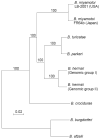Borrelia miyamotoi infection in nature and in humans
- PMID: 25700888
- PMCID: PMC4470780
- DOI: 10.1016/j.cmi.2015.02.006
Borrelia miyamotoi infection in nature and in humans
Abstract
Borrelia miyamotoi is a relapsing fever Borrelia group spirochete that is transmitted by the same hard-bodied (ixodid) tick species that transmit the agents of Lyme disease. It was discovered in 1994 in Ixodes persulcatus ticks in Japan. B. miyamotoi species phylogenetically cluster with the relapsing fever group spirochetes, which usually are transmitted by soft-bodied (argasid) ticks or lice. B. miyamotoi infects at least six Ixodes tick species in North America and Eurasia that transmit Lyme disease group spirochetes and may use small rodents and birds as reservoirs. Human cases of B. miyamotoi infection were first reported in 2011 in Russia and subsequently in the United States, Europe and Japan. These reports document the public health importance of B. miyamotoi, as human B. miyamotoi infection appears to be comparable in frequency to babesiosis or human granulocytic anaplasmosis in some areas and may cause severe disease, including meningoencephalitis. The most common clinical manifestations of B. miyamotoi infection are fever, fatigue, headache, chills, myalgia, arthralgia, and nausea. Symptoms of B. miyamotoi infection generally resolve within a week of the start of antibiotic therapy. B. miyamotoi infection should be considered in patients with acute febrile illness who have been exposed to Ixodes ticks in a region where Lyme disease occurs. Because clinical manifestations are nonspecific, etiologic diagnosis requires confirmation by blood smear examination, PCR, antibody assay, in vitro cultivation, and/or isolation by animal inoculation. Antibiotics that have been used effectively include doxycycline for uncomplicated B. miyamotoi infection in adults and ceftriaxone or penicillin G for meningoencephalitis.
Keywords: Borrelia miyamotoi; Ixodes; Lyme disease; relapsing fever; spirochete; tick-borne disease.
Copyright © 2015 The Authors. Published by Elsevier Ltd.. All rights reserved.
Figures



References
-
- Fukunaga M, Takahashi Y, Tsuruta Y, Matsushita O, Ralph D, McClelland M, Nakao M. Genetic and phenotypic analysis of Borrelia miyamotoi sp. nov. isolated from the ixodid tick Ixodes persulcatus, the vector for Lyme disease in Japan. Internat J System Bacteriol. 1995;45:804–810. - PubMed
-
- Scoles GA, Papero M, Beati L, Fish D. A relapsing fever group spirochete transmitted by Ixodes scapularis ticks. Vector Borne Zoonotic Dis. 2001;1:21–34. - PubMed
Publication types
MeSH terms
Substances
Grants and funding
LinkOut - more resources
Full Text Sources
Other Literature Sources
Medical

